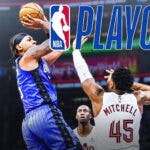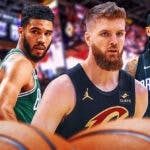Regardless of what Cleveland does this season, be it a rebuild or a continuation of their competitive run, the Cavaliers need young talent. When building a team around LeBron James, the Cavalier Front office prioritized established older players rather than taking gambles on young talent.
This was a valid and justified roster construction strategy at the time as Cleveland couldn’t risk spending a year in development with LeBron James under contract. The result saw the Cavaliers trading away picks, young players, and prospects, leaving their war chest effectively dry. At this point in the free agency period, there aren’t any established stars left and only the occasional few established role players remain. There are, however, a significant number of young developmental players which would be worth taking a gamble on.
Signing a young player to a $4 million dollar a year contract for multiple years and letting them develop can occasionally result in a value contract where the player significantly outperforms their salary. Each of the players on this list represents one such player and guys the Cavaliers should target.

David Nwaba
When Nwaba was cut by the Chicago Bulls it was considered surprising by those in NBA media circles. After all, Nwaba proved himself an impressive prospect who could carve out a long NBA career as an energy backup guard. Yet the 25-year-old combo guard has found himself out in the cold, with a few teams sniffing around but no one making a firm commitment yet.
Nwaba has some clear weaknesses, most notably a lack of shooting from the guard position. He shoots a career 33% from three (though it represents a notable improvement from his rookie season where he shot 20% from three) and isn’t a particularly prolific scorer. Additionally, with a higher workload this past season his turnover rate increased (though this comes with an increased assist rate so statistically, it balances out).
This, however, is where the criticisms end. Nwaba is an exceptional driver and finisher at the rim. With a .51% field goal percentage, his statistics compare well against other top end guards such as Victor Oladipo and Klay Thompson. Additionally, Nwaba averages an impressive 4 rebounds a game on only around 20 minutes of play. This is thanks to the most impressive aspect of Nwaba’s, his physicality.
Similar to Boston’s backup energy guard, Marcus Smart, Nwaba plays significantly larger than his size. Averaging 2.6 blocks + steals per 36 minutes of play, it’s easy to watch the 6’4 guard jump for a rebound or block a putback attempt and think you’re watching an undersized forward. His 7’0 wingspan makes him an effective defensive end player who can switch onto the 1-3 positions with ease. In addition to man-on-man defensive efforts, Nwaba offers strong switch defense potential. His lateral quickness and defensive tenacity allow him to beat screens and keep up with the pop shooter or quickly move over when called for a double team.
At age 25, Nwaba might not fit into the timeline of a total rebuild. Nwaba’s skill level and physical talents have effectively reached their peak and should likely plateau over the course of his next two contracts. This, however, shouldn’t restrict Cleveland from chasing an offer, especially a longer-term deal on a low salary. Offering a 3-year, $12 million dollar contract wouldn’t push the Cavaliers significantly into the Luxury Tax (not at all if they don’t agree to terms with Rodney Hood) and could easily be flipped for an asset from a backup point guard-needy contender after more time showcasing Nwaba’s on-court value.
Tyler Ulis

From an oversized point guard to an undersized one, Tyler Ulis represents another potential flyer option Cleveland could take at backup point guard. At age 23, he still has room to expand his game, though his physical aspects raise continue to raise questions. Ulis clocks in at just 5’10, 150 pounds, extremely small compared to the average NBA player. However, similar to his shot peers Isaiah Thomas and Kay Felder, Ulis makes up for his lack of physical tools with high end handling and shooting.
Ulis’s primary strength as a point guard comes from his IQ. Ulis shows incredible decision-making when it comes to running an offense. During his 2016 summer league, Ulis averaged 6.3 assists a game which translated during his limited minutes on the court these past two seasons. This helps mitigate the disadvantage created by his undersized frame, as Ulis generally leaves the driving and scoring to whoever he dishes the ball to.
For example with 11:37 left in the first quarter (effectively the first play of the game) in the April 2nd, Ulis reads that Shaquille Harrison beat the defense and tossed up an otherwise reckless lob from the key. The pass lands right at Harrison’s eye level for a perfect transition dunk. With 7:01 left in the third quarter, Ulis makes a similar lob pass, this time from the opposing three-point line. Ulis ended that night with 34 points, 9 assists, and 9 rebounds showing off tantalizing potential.
Ulis shows an excellent handle as well. One major criticism of Ulis’s potential game is that his undersized frame makes driving a difficult task. As Cavaliers rookie Colin Sexton found out this during his summer league, NBA bigs generally have faster reaction times than college level player, making drives against larger players more difficult. Instead, Ulis adapts his own game, using his handles, not for drives, but to create space. Shooting 54.1% on shots within 10 feet and 45% on pull-ups, Ulis often draws defenders into the paint just to step back and pop off a midrange jumper in space. Overall, Ulis’s offensive game can be best described as versatile.
On the defensive end, Ulis predictably struggles. At 5’10, opposing guards generally just blow by, requiring a team hide Ulis on the defensive end. That said, Ulis isn’t useless. His defensive game plays with hustle, oftentimes jumping from behind for a block or pestering his opposing number with fast hands. There are questions regarding if Ulis can ever hold his own against larger guards. However, possible scenarios in the future where Ulis is generally considered a neutral defender.
Pat Connaughton
https://www.youtube.com/watch?v=0qO-6I3ZvKU
Here’s a fun fact about Pat Connaughton, he can throw a 94 mile an hour fastball. Connaughton’s basketball skills were so impressive that he found himself drafted by the Baltimore Orioles in the fourth round of the 2014 MLB draft. Now he finds himself one of the few high upside players left in 2018 NBA free agency.
Connaughton finds himself a casualty of the luxury tax. After Portland signed experienced shooting guard Nik Stauskas, Connaughton found himself expendable. As a result, Portland refused to extend a qualifying offer to the 2015 draft pick.
The decision to not retain Connaughton as a restricted free agent shouldn’t affect his value. Connaughton is a consummate professional with proven NBA rotation value. Averaging 18 minutes a game this past season, Connaughton can not only stay on the floor against NBA competition but generally provides value in all the aspects a rotation wing should. His defensive effort is commendable, he offers positive spacing as a spot up shooter (the Blazers shot 50.7% from the field when Connaughton started last season) and plays an incredibly conservative, mistake-free, style.
https://www.youtube.com/watch?v=S9Pgvsw5QUw
Connaughton has his weaknesses as a prospect, as almost all do. He can read the offense well enough but doesn’t have the physical skills to beat the switch he knows is coming. Rather, his reads serve him best by letting him get to a preferred shooting spot.
That offensive game, while useful, solidifies Connaughton’s likely career position as a backup wing. Additionally, Connaughton thrives next to a strong passing point guard, which makes his fit next to the defensive-minded, score first Colin Sexton somewhat questionable.
When it comes to evaluating Connaughton’s game, the best word that comes to mind is fundamental. This is both a strength and a weakness. As mentioned before, Connaughton plays by the book: He shoots with good form. He plays above-average man-to-man defense and can read the plays to switch. He has high levels of athleticism. But this isn’t always a good thing.
Connaughton’s reliance on the basic principles of basketball means he really can’t break them to reach the next level. While the top end wings in the NBA employ creativity and finesse when driving to the basket, Connaughton’s ball-handling skills are mediocre at best. Connaughton’s read and react style of defense leaves him susceptible to offensive fake outs and traps.
Effectively Connaughton’s best offensive and defensive matchups aren’t by position, but rather by playstyle. Put a group of five NBA players whose games look like high-level demonstration videos and Connaughton can torch them. Play at a staggered pace, run unconventional sets, or rely on trick reads and last-second passes and Connaughton just looks lost in the cold.
Luckily for the Cavaliers, his worst-case scenario ends with Connaughton signing with the Cleveland Indians. I hear they can always use another pitcher in the bullpen.




